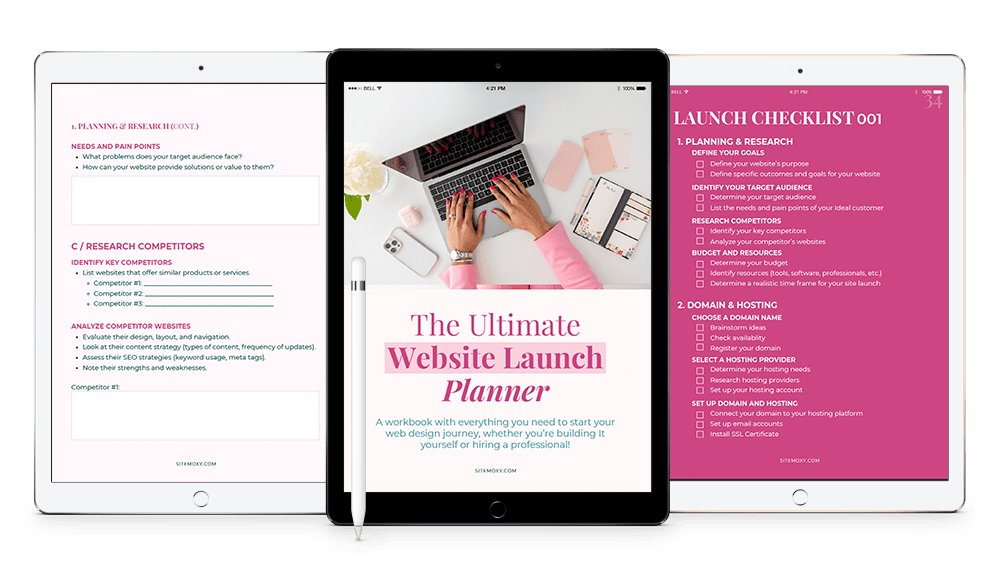The Power of UX in Web Design

When you think about your favorite websites, what makes them stand out?
Maybe it’s the smooth navigation, the eye-catching visuals, or how everything just seems to “click” together effortlessly.
That’s the magic of User Experience (UX) design, and if you’re a small business owner, it’s something you can’t afford to ignore.
In the digital world, your website is often the first impression potential customers get of your brand. It’s your 24/7 storefront, salesperson, and customer service rep all rolled into one. So, if your website isn’t pulling its weight, you could be missing out on some serious opportunities.
That’s where UX comes in—a smart, thoughtful approach to design that puts your users front and center. It’s not just about making things look pretty (though that’s definitely part of it); it’s about creating a seamless, enjoyable experience that keeps people coming back for more.
Let’s dive into why UX is so crucial for small businesses and how it can elevate your website from “meh” to “wow.”
What Exactly Is UX?
User Experience (UX) is all about how users interact with your website. It encompasses everything from the way your site looks and feels to how easy it is to find information and complete tasks.
Good UX design makes these interactions smooth, intuitive, and enjoyable.
It’s about anticipating your users’ needs and delivering solutions in a way that feels almost effortless.
Think of UX as the secret sauce that takes a website from functional to fantastic. It’s not just about ticking boxes on a checklist; it’s about crafting an experience that resonates with your audience, makes their lives easier, and—most importantly—makes them want to do business with you.
Why UX Matters for Small Businesses
As a small business owner, you might be wondering, “Isn’t UX something only big companies need to worry about?” The short answer: absolutely not! In fact, UX is arguably even more critical for small businesses. Here’s why:
1. First Impressions Matter
When someone lands on your website, you’ve got about 0.05 seconds to make a good first impression. That’s less time than it takes to blink!
A well-designed UX can make that split second count by instantly communicating professionalism, trustworthiness, and value.
real world example
Imagine you’re a boutique owner with a website that sells handmade jewelry. If your site is slow to load or has confusing navigation, potential customers might leave before even seeing your beautiful products.
But if your site is fast, visually appealing, and easy to navigate, users are more likely to stick around, browse your collections, and make a purchase.
2. Conversion Rates Soar
A website with great UX doesn’t just look good—it performs well, too.
When users can easily navigate your site, find what they’re looking for, and complete actions without friction, they’re more likely to convert.
Whether that means making a purchase, signing up for a newsletter, or booking an appointment, a smooth UX leads to more conversions.
Pro Tip
Incorporate clear calls to action (CTAs) throughout your site. Whether it’s a “Buy Now” button, a newsletter sign-up form, or a “Contact Us” link, make sure your CTAs are easy to find and understand.
A well-placed CTA can significantly boost your conversion rates.
3. User Retention
It’s one thing to get people to visit your website; it’s another to keep them coming back. A positive user experience encourages repeat visits and fosters loyalty. Plus, satisfied users are more likely to spread the word about your business, leading to that oh-so-important word-of-mouth marketing.
Example
Let’s say you own a local coffee shop and you’ve set up an online store for your artisanal coffee beans.
If your website offers a seamless shopping experience, with easy navigation, fast checkout, and helpful product descriptions, customers are more likely to return for repeat purchases—and they might even tell their friends about it.
4. Competitive Edge
Let’s face it—small businesses often have to work harder to stand out from the crowd.
A killer UX can give you the edge you need by differentiating your brand and showing customers that you’re willing to go the extra mile to make their experience enjoyable.
Storytime
Consider a small online bookstore competing against big players like Amazon. While the bookstore can’t compete on price or inventory size, it can offer a superior browsing experience.
Thoughtful touches like personalized book recommendations, an easy-to-navigate layout, and a warm, inviting design can set the bookstore apart and attract a loyal customer base.
Think it might be time for a site redesign? Find out more here:
5. SEO Benefits
Google and other search engines love a well-designed website. UX plays a significant role in SEO (Search Engine Optimization), as factors like site speed, mobile responsiveness, and user engagement are all taken into account when ranking websites.
In other words, better UX can help your website rank higher in search results, making it easier for potential customers to find you.
SEO Insight
If you’re aiming to improve your website’s SEO, don’t overlook the importance of UX. Google’s algorithms are increasingly favoring websites that provide a great user experience.
By focusing on UX, you’re not only making your site more user-friendly—you’re also giving it a better chance to climb up the search rankings.
The Elements of Great UX Design
Now that we’ve established why UX is so important, let’s talk about what makes up a great user experience.
Here are some key elements to consider when designing or revamping your small business website:
Simplicity and Clarity
The best websites are easy to navigate and understand. Don’t overwhelm users with too many options or cluttered layouts.
Instead, focus on clear, concise messaging and straightforward navigation. Remember, less is often more.
case study
Apple’s website is a prime example of simplicity and clarity in action. Despite being a global tech giant with a vast product line, Apple’s website is clean, uncluttered, and easy to navigate.
Each product has its own page with detailed yet digestible information, making it easy for users to find what they need without feeling overwhelmed.
Mobile Optimization
With more people browsing on their phones than ever before, a mobile-friendly design is a must.
Ensure your website looks and functions just as well on a smartphone or tablet as it does on a desktop.
This means responsive design, touch-friendly buttons, and fast load times.
Did You Know?
As of 2024, over 60% of all web traffic comes from mobile devices.
That’s a huge chunk of potential customers you could be missing out on if your site isn’t mobile-optimized.
Make sure your site adapts to different screen sizes and offers a seamless experience on the go.
Intuitive Navigation
Users should be able to find what they’re looking for without having to think too hard.
Your navigation should be logical, well-organized, and consistent across all pages.
Include a search bar for added convenience, especially if your site has a lot of content.
Quick tip
Use familiar navigation terms like “Home,” “About Us,” “Services,” and “Contact” to make it easy for users to find what they need.
Avoid using jargon or overly creative labels that might confuse visitors.
Fast Load Times
In our fast-paced world, no one has the patience to wait for a slow website.
Optimize images, minimize code, and leverage browser caching to ensure your site loads quickly. A delay of even a few seconds can lead to higher bounce rates and lost business.
Pro Tip
Tools like Google PageSpeed Insights can help you identify areas where your site’s speed could be improved.
Regularly check your site’s performance and make adjustments as needed to keep those load times snappy.
Accessible Design
Your website should be accessible to all users, including those with disabilities. This means using proper color contrast, providing alt text for images, and ensuring your site can be navigated with a keyboard.
Accessible design isn’t just good practice—it’s often a legal requirement.
Why it matters
Accessibility isn’t just about compliance—it’s about inclusivity.
By making your website accessible, you’re ensuring that everyone, regardless of their abilities, can engage with your brand.
This not only broadens your audience but also reflects positively on your brand’s values.
Engaging Visuals
While UX isn’t just about aesthetics, a visually appealing design can enhance the overall experience.
Use high-quality images, consistent branding, and thoughtful use of color and typography to create a cohesive and engaging look.
example
Take a look at your favorite lifestyle blogs or online boutiques.
Chances are, the visuals play a big role in drawing you in. Beautiful imagery, cohesive branding, and well-chosen typography create an inviting atmosphere that encourages you to stay and explore.
User Feedback
Don’t forget to include opportunities for user feedback.
Whether it’s through surveys, contact forms, or user testing, gathering feedback is crucial for ongoing improvements.
It also shows your customers that you value their opinions and are committed to providing the best possible experience.
actionable idea
Consider implementing a feedback widget on your site that allows users to quickly share their thoughts.
Whether it’s a quick star rating, a comment box, or a more detailed survey, user feedback is invaluable for refining your UX.
Free Download! The Ultimate Website Launch Planner
Download this free workbook with everything you need to start your web design journey, whether you’re building It yourself or hiring a professional!

How to Incorporate UX into Your Small Business Website
So, how do you go about incorporating UX into your website? Here are some actionable steps you can take:
1. Know Your Audience
Start by understanding who your users are and what they need.
Create user personas to represent different segments of your audience, and think about how they might interact with your site.
What are their goals? What challenges might they face? Use this information to guide your design decisions.
Pro Insight
User personas are fictional characters based on real data about your audience.
By developing these personas, you can better tailor your website to meet the specific needs and preferences of different user groups.
For example, if one of your personas is a busy mom looking for quick meal ideas, your site should prioritize easy navigation and fast access to recipes.
2. Plan the User Journey
Map out the user journey from start to finish.
What’s the first thing users see when they land on your site? How do they navigate from one page to the next?
Identify any potential pain points and look for ways to streamline the process.
Interactive Idea
Consider creating a user flow diagram—a visual representation of the paths users take to complete tasks on your site.
This can help you identify any bottlenecks or areas where users might get stuck and allow you to optimize those flows for a smoother experience.
3. Design with Intent
Every element on your website should serve a purpose.
Whether it’s guiding users toward a specific action, providing information, or enhancing the visual appeal, be intentional with your design choices.
Avoid unnecessary distractions and focus on creating a clear, cohesive experience.
Example
If you’re designing a landing page for a product launch, everything on that page should be geared toward driving conversions.
This means minimizing distractions, highlighting the product’s benefits, and placing a strong call-to-action front and center.
4. Test, Test, Test
UX design is an ongoing process, and testing is key to getting it right.
Conduct usability tests with real users to identify any issues or areas for improvement. Use A/B testing to compare different design elements and see what works best.
And don’t forget to analyze your site’s performance metrics to track user behavior and make data-driven decisions.
pro tip
Usability testing doesn’t have to be complicated or expensive.
Even a small group of users can provide valuable insights. Tools like UserTesting or Hotjar can help you gather feedback and see how users interact with your site in real-time.
5. Stay Up-to-Date
The digital landscape is constantly evolving, and so are user expectations.
Stay on top of the latest UX trends and best practices to ensure your website remains relevant and effective.
This might mean updating your design, adding new features, or optimizing for emerging technologies like voice search or artificial intelligence.
trend alert
One of the emerging trends in UX is the use of micro-interactions—subtle animations or responses that occur in response to user actions.
These can add a layer of delight to your website, making it feel more dynamic and engaging. However, use them sparingly to avoid overwhelming users.
Common UX Mistakes to Avoid
While it’s important to focus on what makes for a great user experience, it’s equally crucial to avoid common UX pitfalls.
Here are a few mistakes to watch out for:
Ignoring Mobile Users
We’ve mentioned this already, but it bears repeating—mobile optimization is non-negotiable.
If your site isn’t mobile-friendly, you’re alienating a significant portion of your audience.
example
Imagine a local restaurant with a website that doesn’t function well on mobile.
Potential customers trying to find the menu or make a reservation on their phones might get frustrated and move on to a competitor’s site.
That’s a missed opportunity that could easily be avoided with mobile optimization.
Overcomplicating the Design
It’s easy to get carried away with flashy graphics and complex layouts, but remember that simplicity is key.
A cluttered or confusing design can frustrate users and drive them away.
pro tip
If you’re unsure whether your design is too complicated, conduct a “five-second test.”
Show your website to someone for just five seconds, then ask them what they remember. If they can’t recall the main purpose or message, your design might need simplification.
Neglecting Accessibility
Accessibility isn’t just a nice-to-have; it’s essential.
Failing to make your website accessible to all users can result in legal issues and a tarnished reputation.
insight
Accessible design benefits everyone, not just those with disabilities.
For example, captions on videos can help non-native speakers understand your content better, while keyboard navigation can make your site easier to use for people with temporary injuries.
Forgetting About Content
UX isn’t just about visuals—it’s also about content.
Ensure your copy is clear, concise, and aligned with your brand voice.
Break up large chunks of text with headings, bullet points, and visuals to make it more digestible.
content tip
Use a conversational tone in your copy to make your content more relatable and engaging.
Instead of saying, “We offer a variety of services to meet your needs,” try something like, “Looking for help? We’ve got you covered with a range of services designed just for you.”
Ignoring User Feedback
Don’t fall into the trap of thinking you know best.
User feedback is invaluable for identifying issues and making improvements.
Make it easy for users to share their thoughts and take their input seriously.
Actionable Idea
Implement a “voice of the customer” program where you regularly review and act on user feedback.
This could be as simple as holding monthly meetings to discuss common issues or running quarterly surveys to gather fresh insights.
The Wrap Up
Incorporating UX into your small business website isn’t just about making things look nice—it’s about creating a powerful tool for growth. A website with great UX can help you attract more visitors, convert them into customers, and keep them coming back for more.
By focusing on the needs of your users and delivering a seamless, enjoyable experience, you’re not just building a website—you’re building a brand that people trust and love. And in today’s competitive digital landscape, that’s something every small business should strive for.
So, take the time to invest in UX. Whether you’re starting from scratch or looking to improve an existing site, a user-centered approach can make all the difference. Remember, your website is more than just a digital brochure—it’s a critical component of your business’s success. Make sure it’s working as hard as you are.
If you need help along the way, you know where to find me. 😉
Free Download! The Ultimate Website Launch Planner
Download this free workbook with everything you need to start your web design journey, whether you’re building It yourself or hiring a professional!

Share:
You May Also Love...
Interested in Custom Web Design Services?







